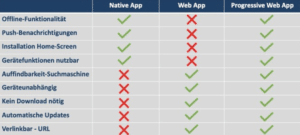Progressive Web Apps – This is how big the impact is on e-commerce
Progressive Web Apps are receiving more and more attention. But is this really justified and what concrete benefits arise for the e-commerce sector? Prof. Geibel and Robin Kracht present how Progressive Web Apps can be used to optimize conversion rates in e-commerce:
This article takes a closer look at the topic of Progressive Web Apps and the benefits in relation to e-commerce. For this purpose, a definition as well as the most important characteristics of the new technology will be presented first, before the concrete potentials for companies in the area of e-commerce will be discussed.
In summary, this article will answer the question of the extent to which the new technology can be used to optimize conversion rates in e-commerce.
What is a PWA?
A Progressive Web App (PWA) is a new app format for which Google in particular sees itself as responsible. The PWA is loaded directly from the Internet and not from an app store onto the end device. This means that it is available independently of the app store. Established web technologies are used for development (HTML5, CSS3, JavaScript). The PWA is detached from a device-specific operating system and accessible via a URL, as it is executed via a web browser.
The new technology makes it possible to combine the positive features of native apps (from the App Store) and web apps (mobile-optimized websites), making it a very powerful alternative.
What are the positive features?
PWAs convince with several positive features. The focus is particularly on the device- and browser-independent development effort, which is significantly lower and thus also more cost-effective than usual. Only one programming code is needed, which works on any web browser. Furthermore, the application can be used offline, since important content is stored in the browser’s cache and can therefore be accessed offline. Because of the content in the cache, PWAs also have extremely fast loading times when opening or changing pages. Access to various device-specific functions is also made possible for the first time, i.e. functions such as camera, content sharing or payment can be listed in PWAs. This was previously not possible with the usual web apps. Installation on the cell phone or desktop is possible with just one “click” and is therefore much shorter than the familiar app download process (usually consists of five steps). Another advantage results from the independence from an app store, namely the independent distribution. Thus, operators of a PWA do not have to give a percentage share to the app store operator for in-app purchases, which results in an immediate increase in profit.
When is a PWA suitable for my company?
A PWA can be worthwhile for a number of reasons. If the loading speed of the application, high availability (offline), and data and storage savings are important to a company, it can use a PWA with a clear conscience. Even if the development costs of a native app have been too high so far or a relaunch is planned anyway, the alternative PWA should be concretely discussed. Another argument for a PWA is that the high commission fees from the app stores are saved. As a result, business models that were previously considered unattractive can now work after all.
Ultimately, however, the likelihood of success always depends on user acceptance, which can be increased by professional UX and UI design.
Potential for e-commerce companies
Especially companies with a focus on e-commerce can benefit greatly from PWAs. This is because a much better SEO ranking of the website is made possible, which is due to the high speed and low memory requirements of the PWA. In addition, PWAs are generally strongly rewarded and better rated by Google. It has been proven that site visitors spend more time on PWAs than on normal websites, which is also due to the offline functionality. Furthermore, PWAs have lower bounce rates because the pages load immediately – this is also reflected in the revenue of the pages. Push notifications are a popular means of contact. These can also be used with PWAs and thus increase the number of returning customers.
Finally, the increased visibility of the application must be mentioned. This is because by simply downloading it, the application icon is directly visible on the cell phone or the desktop, and thus it appears more often to the end user.
Conclusion
The new PWAs clearly have the potential to increase conversion rates at companies and thus also help shape the future of the Internet. Overall, the new app format makes the mobile web more user-friendly, and PWAs are also uncomplicated, platform-independent and can be used without installation. Furthermore, a rapid spread, due to the independence of the operating system, is to be expected. In summary, on the one hand more users are attracted by the better findability and on the other hand they even stay longer on the website due to the high performance.
Source: https://www.marktforschung.de/dossiers/themendossiers/e-commerce-boom/dossier/progressive-web-apps-so-gross-ist-der-einfluss-auf-den-e-commerce/


